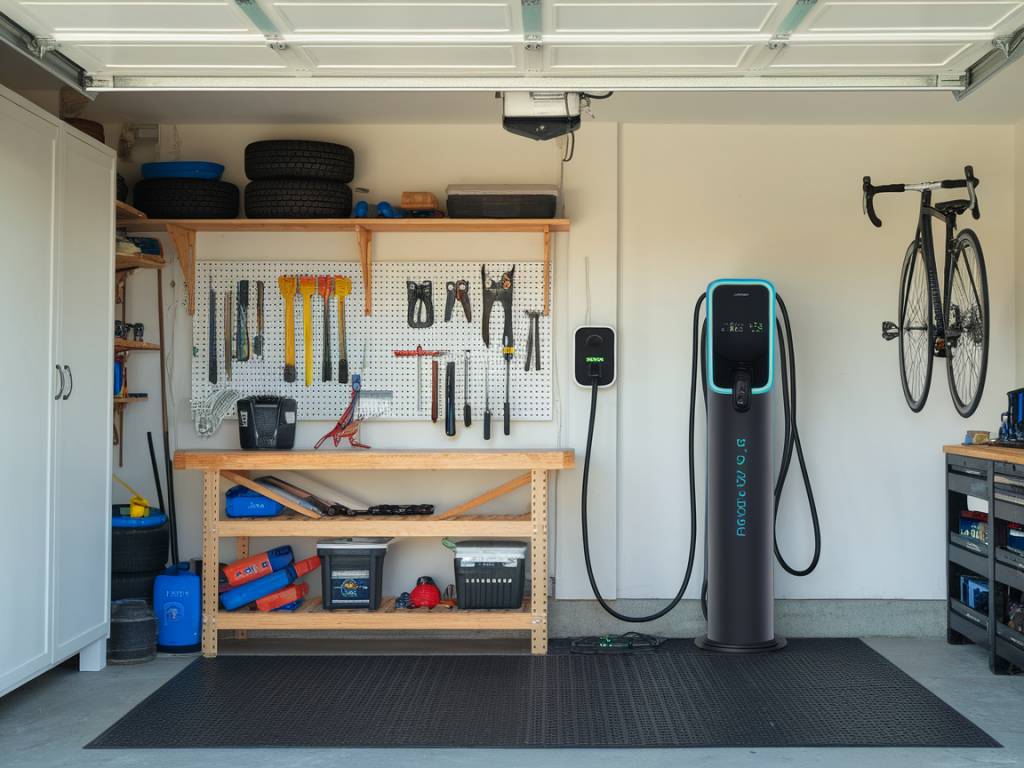how to prep your garage for an at-home ev charging station

how to prep your garage for an at-home ev charging station
As electric vehicles (EVs) become increasingly popular, more and more homeowners are considering installing an EV charging station in their garages. Preparing your garage for an at-home EV charging station involves several important steps, from planning and electrical upgrades to safety considerations and installation. This comprehensive guide will walk you through everything you need to know to get your garage ready for charging your EV right at home.
Evaluate Your Garage Space
The first step in preparing your garage for an EV charging station is to assess the available space. You’ll need to determine where the charging station will be installed and ensure that the location is convenient and accessible for plugging in your EV. Consider the following factors:
- Access to a power source
- Proximity to the EV parking area
- Space for cable management
- Clearance for ventilation and cooling
- Ease of access for installation and maintenance
It’s also important to consider where you’ll store the charging equipment when it’s not in use. Wall-mounted chargers often come with cable management solutions like hooks or reels, but you’ll want to make sure there’s enough room for these additions in your garage.
Assess Your Home’s Electrical System
One of the most critical steps in preparing your garage for an EV charging station is evaluating your home’s electrical system. Most Level 2 charging stations require a dedicated 240-volt circuit, so you’ll need to ensure that your electrical panel can support this addition. Here’s how to get started:
- Check your home’s electrical panel rating (often found on a label inside the panel door).
- Determine if you have available circuit breaker slots for the new circuit.
- Consider the total electrical load of your household to ensure you don’t exceed the panel’s capacity.
- Consult with a licensed electrician to evaluate whether any upgrades are necessary.
If your home’s electrical panel is at capacity or outdated, you may need to upgrade it to support the new EV charging station. This can be a significant investment, so it’s essential to plan accordingly.
Choose the Right EV Charging Station
There are several types of EV charging stations available, so it’s important to choose one that suits your needs and your vehicle. The two most common types for home use are:
- Level 1 Charger: Uses a standard 120-volt outlet, providing a slower charging rate (approximately 3-5 miles of range per hour).
- Level 2 Charger: Requires a 240-volt outlet and offers a faster charging rate (approximately 10-60 miles of range per hour, depending on the charger and the vehicle).
For most EV owners, a Level 2 charger is the preferred choice for home use due to its faster charging capabilities. When selecting a charger, consider the following factors:
- Charging speed (measured in kilowatts, or kW)
- Compatibility with your specific EV model
- Smart features such as Wi-Fi connectivity and mobile app controls
- Warranty and customer support options
- Ease of installation and maintenance
Be sure to read reviews and compare different models to find the best EV charging station for your needs.
Plan for Installation
Once you’ve chosen the right EV charging station, it’s time to plan for installation. Here are the steps to follow:
- Hire a licensed electrician: An experienced electrician will ensure that the installation is done safely and in compliance with local codes and regulations.
- Obtain necessary permits: Check with your local building department to see if you need any permits for the installation of the EV charging station.
- Prepare the installation site: Clear the area where the charging station will be installed and make any necessary modifications, such as mounting brackets or conduit for the electrical wiring.
- Schedule the installation: Coordinate with your electrician to schedule the installation at a convenient time. The installation process will typically take a few hours, depending on the complexity of the setup and any necessary electrical upgrades.
Ensure Safety and Compliance
Safety is paramount when installing an EV charging station in your garage. Follow these guidelines to ensure that your setup is safe and compliant with all relevant regulations:
- Install ground fault circuit interrupters (GFCIs) to protect against electrical shock.
- Ensure that all wiring and connections are rated for the appropriate voltage and amperage.
- Follow manufacturer instructions for mounting and connecting the charging station.
- Keep the charging area free of flammable materials and clutter.
- Label the dedicated circuit breaker for the charging station in your electrical panel for easy identification.
- Schedule regular inspections and maintenance to ensure the system remains in good working order.
If you’re unsure about any aspect of the installation, consult with a licensed electrician or your local building department for guidance.
Organize Your Garage
Having an EV charging station in your garage means that you’ll need to keep the area organized to avoid any potential hazards. Here are some tips to help you maintain a tidy and functional space:
- Install shelves or cabinets to store tools and other items.
- Use hooks or cable management systems to keep charging cables neat and out of the way.
- Ensure that the charging area is well-lit for easy access at night.
- Consider adding a dedicated mat or protective flooring under the charging station to prevent damage from potential spills or accidents.
- Regularly clean and declutter the garage to maintain a safe and efficient charging environment.
An organized garage not only makes it easier to use your EV charging station but also enhances the overall safety and functionality of the space.
Consider Future Needs
As technology evolves and you potentially add more electric vehicles to your household, it’s wise to plan for future needs. Consider the following:
- Installing a charging station with multiple ports if you anticipate more than one EV.
- Choosing a charging station that supports higher charging speeds or future upgrades.
- Ensuring that your electrical panel has the capacity to handle additional loads.
- Planning the layout of your garage to accommodate more EVs and charging equipment.
By planning ahead, you can ensure that your home remains equipped to handle your EV charging needs for years to come.
Preparing your garage for an at-home EV charging station requires careful planning, thoughtful consideration of your home’s electrical system, and a focus on safety and organization. By following the steps outlined in this guide, you can create a convenient and efficient charging setup that meets your current and future EV needs. Whether you’re a new EV owner or upgrading your existing charging infrastructure, taking the time to properly prep your garage will make the experience seamless and enjoyable.





